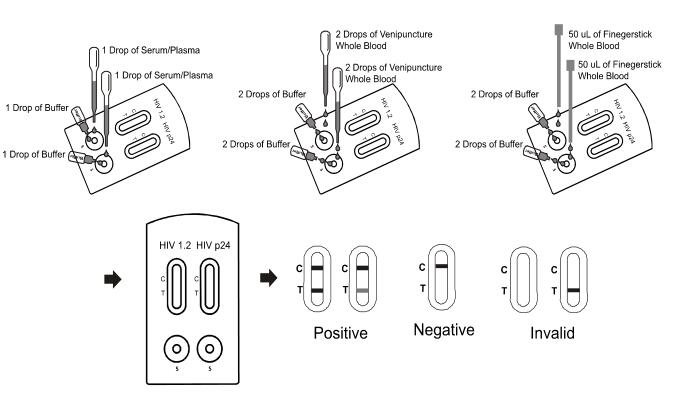【SUMMARY】
-HIV 1.2
HIV (Human Immunodeficiency Virus) is the etiologic agent of Acquired Immune Deficiency Syndrome (AIDS). The virion is surrounded by a lipid envelope that is derived from host cell membrane. Several viral glycoproteins are on the envelope. Each virus contains two copies of positive-sense genomic RNAs. HIV 1 has been isolated from patients with AIDS and AIDS-related complex, and from healthy people with high potential risk for developing AIDS. HIV 2 has been isolated from West African AIDS patients and from seropositive asymptomatic individuals. Both HIV 1 and HIV 2 elicit immune response. Detection of HIV antibodies in whole blood, serum or plasma is the most efficient and common way to determine whether an individual has been exposed to HIV and to screen blood and blood products for HIV. Despite the differences in their biological characteristics, serological activities and genome sequences, HIV 1 and HIV 2 show strong antigenic cross-reactivity. Most HIV 2 positive sera can be identified by using HIV 1 based serological tests.
The HIV 1.2 Rapid Test (Whole Blood/Serum/Plasma) is a rapid test to qualitatively detect the presence of antibodies to HIV type1 and type 2 in whole blood, serum or plasma specimen.
-HIV p24
The HIV p24 antigen is a small piece of protein that is found on the capsule of the HIV virus. When a person is infected with HIV, these bits of protein can be found floating in the blood. The HIV p24 antigen rapid test is the test that detects these bits of protein.
This test was first developed as a HIV screening test but rapidly ran out of favor due to the development of more advanced NAT tests. The window period for p24antigen testing is also very small. This test alone is only accurate for between 3 and 6 weeks post exposure. So it is a test with very limited applications unless combined with HIV antibody test. The presence of p24 antigen in the blood indicated a recent HIV infection.
The HIV p24 Antigen Rapid Test (Whole Blood/Serum/Plasma) is a rapid test to qualitatively detect the presence of p24 antigen to HIV 1 in whole blood, serum or plasma specimen. The test utilizes latex conjugate HIV p24 antibody to selectively detect p24 antigen to the HIV type 1 in whole blood, serum or plasma.
【DIRECTIONS FOR USE】
Allow the test, specimen, buffer and/or controls to reach room temperature (15- 30°C) prior to testing.
1. Bring the pouch to room temperature before opening it. Remove the test Cassette from the sealed pouch and use it as soon as possible.
2. Place the Cassette on a clean and level surface.
For Serum or Plasma specimen: Hold the dropper vertically and transfer 1 drop of serum or plasma (approximately 25 μl) to the specimen area of test Cassette, then add 1 drop of buffer (approximately 40 μl),and start the timer, see illustration below.
For Venipuncture Whole Blood specimen:
Hold the dropper vertically and transfer 2 drops of whole blood (approximately 50 μl) to the specimen area of test Cassette, then add 2 drops of buffer (approximately 80 μl), and start the timer. See illustration below.
For Fingerstick Whole Blood specimen:
To use a capillary tube: Fill the capillary tube and transfer approximately 50 μl of fingerstick whole blood specimen to the specimen area of test Cassette, then add 2 drops of buffer(approximately 80 μl), and start the timer. See illustration below.
3. Wait for the colored line(s) to appear. Read results at 10 minutes. Do not interpret the results after 20 minutes.
Note: It is suggested not to use the buffer, beyond 30 days after opening the vial.

| Cat. No. | Product Description | Specimen | Format | Kit Size | Cut-Off | Status |
| IHIBG-425 | HIV 1.2 and HIV P24 Combo Rapid Test Cassette | WB/S/P | Cassette | 25 T | See Insert | Non-CE |
 Malaysia
Malaysia